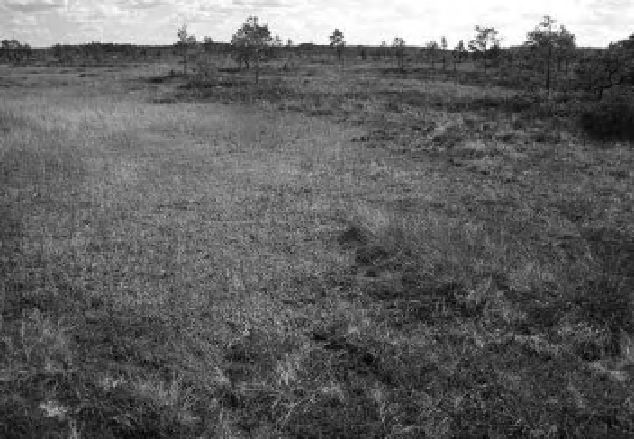Geoscience Reference
In-Depth Information
Figure 10-7.
Oligotrophic bog in Finland showing hollow in foreground and hummock with sparse pines in the
background (see Color Plate 10-7). Both productivity and decay are limited by the short growing season, anaerobic
conditions, low pH, lack of nutrients, and cold temperature. Photo courtesy of E. Volkova.
although the rates of productivity and decay are
difi cult to estimate accurately or measure
directly. The exception is northern peatlands
dominated by
Sphagnum
mosses with low pro-
ductivity, but decay rate is also quite slow in
this setting (Fig. 10-7).
In general, the rate of decay is of greater
importance than productivity for long-term
accumulation of peat (Charman 2002). Decay
rate in peat is determined by temperature, water
content, presence of oxygen, microbes and
animals, and the type of plant material. Decay
is usually faster in the aerobic zone (acrotelm)
and decreases with depth in the anaerobic zone
(catotelm).
Sphagnum
has much slower decay
rates than other hydrophytes; thus, bogs gener-
ally have lower decay rates than fens. Two fun-
damental aspects apply to the peat accumulation
model of Clymo (1984):
amount of decay increases as the thickness of
peat increases. Eventually the total rate of
decay would match the rate of productivity so
that no further peat could accumulate, reach-
ing a steady-state equilibrium. This model
depends on the ideal assumption of constant
conditions and rates, and while the general
concept of this model appears valid, climatic
changes, human impacts, and other wetland
factors have varied signii cantly during the
Holocene (see chapter 9).
10.2.3 Carbon gases and climatic
feedback
Of the two carbon greenhouse gases, methane
has a far greater thermal effect, some 20 times
stronger than carbon dioxide, but methane has
a much shorter lifespan in the atmosphere.
Thus, the release of methane into the atmos-
phere has a strong but short-lived greenhouse
impact, whereas carbon dioxide emission has a
weaker but longer-lasting greenhouse effect
(Charman 2002). Gas production depends to a
large extent on the position of the water table;
a high water table favors methane over carbon
dioxide, and methane production increases
greatly with higher temperature. Temperate
• Acrotelm decay is fast and considerable
material is lost by the time it enters the
catotelm through burial.
• Peat decay continues, albeit at a much slower
rate, in the catotelm.
Given constant rates of productivity and decay
over the long term (millennia), the total





